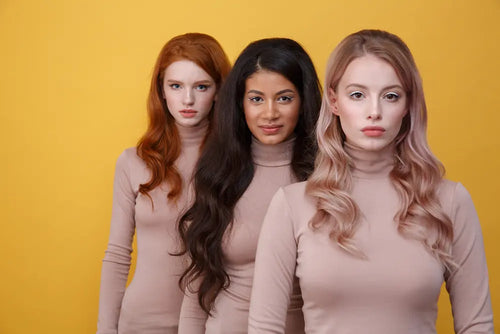Introduction
Not quite straight, not quite curly? Welcome to the world of Type 2 wavy hair—a beautiful, versatile, and often misunderstood texture. If you're tired of guessing whether your hair is 2A or 2B, and frustrated by routines that leave your waves flat or frizzy, you've found your solution.
This definitive guide cuts through the noise. We'll help you pinpoint your exact place on the wavy spectrum (2A, 2B, or 2C) and provide a tailored, step-by-step plan to transform your waves from unpredictable to unforgettable. Let's end the confusion and embrace your natural texture.
Wavy Hair, Decoded: The Type 2 Spectrum
Under the Andre Walker Hair Typing System, Type 2 hair is defined by its distinctive "S" shaped pattern. But not all S-waves are created equal. The spectrum ranges from loose, barely-there bends to strong, defined waves that border on curly.
All Type 2 hair shares a common trait: a raised cuticle layer that makes it inherently prone to frizz. The key to mastering your waves is understanding your specific subtype.
Identify Your Wave Type: 2A, 2B, or 2C?
Use this simple guide to self-diagnose. Remember, it's common to have a mix of patterns!
Type 2A Hair: The "Beachy" Wave
Pattern: Subtle, tousled bends that start at the mid-lengths to ends. The crown often appears straight.
Texture: Fine and soft, with a natural shine but a tendency to fall flat at the roots.
Strengths: Effortlessly chic, easy to straighten or curl, naturally glossy.
Struggles: Gets weighed down easily, struggles to hold definition, lacks volume.
If your waves are delicate and vanish by day two, you're likely 2A.
Type 2B Hair: The "Textbook" Wave
Pattern: Defined, true "S" shapes that start from the mid-lengths. Roots are typically straighter.
Texture: Medium—not too fine, not too coarse. The quintessential beach wave.
Strengths: Great body and movement, that coveted "lived-in" look.
Struggles: Frizz-prone (especially in humidity), roots can look flat, pattern can get stretched out.
If you have clear S-waves but a constant battle with frizz, you're in the 2B club.
Type 2C Hair: The "Strong" Wave
Pattern: Tight, defined S-waves that can start near the roots. May have a few spiral curls mixed in.
Texture: Thick and coarse, with plenty of natural volume and body.
Strengths: Voluminous, holds styles well, defined pattern.
Struggles: Very frizz-prone, tends to be dry, can feel coarse without proper care.
If your hair is thick, voluminous, and almost curly, you're a 2C.

The Golden Rules of Wavy Hair Care
Forget rigid "curly girl" rules. Wavy hair needs a balanced approach.
- Clarify Gently: Buildup is the enemy of definition. Use a sulfate-free clarifying shampoo every 2-4 weeks.
- Balance Moisture & Protein: Soft but flat hair needs protein. Brittle, dry hair needs moisture. Learn to read your hair's signals.
- Scrunch, Don't Break: Scrunching is your #1 technique for encouraging wave formation. Never brush your hair dry.
- Diffuse for Volume: Air-drying can stretch waves. A pixie-diffuse technique adds bounce and fights frizz.
Your Subtype-Specific Product Arsenal
The goal: Enhance your pattern without weighing it down.
For 2A Hair: Lightweight & Volumizing
- Shampoo/Conditioner: Volumizing or clarifying formulas. Avoid heavy oils.
- Stylers: Sea salt sprays, texturizing mousses, light hold gels.
- Avoid: Heavy creams, butters, rich oils.
For 2B Hair: Defining & Frizz-Fighting
- Shampoo/Conditioner: Lightweight hydrators (aloe vera, glycerin).
- Stylers: A lightweight leave-in conditioner paired with a light-hold curl cream or mousse. Finish with a hard-hold gel to lock out humidity.
For 2C Hair: Moisturizing & Controlling
- Shampoo/Conditioner: Hydrating formulas that don't sacrifice volume.
- Stylers: Creamy stylers and stronger-hold gels. This type can handle slightly heavier products than 2A/2B.
- Essential: Weekly deep conditioning treatments.
The Ultimate Step-by-Step Wavy Hair Routine
- Wash & Condition: Use a sulfate-free shampoo. Condition upside down for root volume, focusing on mid-lengths to ends.
- Apply to Soaking Wet Hair: Use the "praying hands" method to smooth product, then scrunch vigorously.
- Micro-Plop: Use a microfiber towel or cotton t-shirt to gently scrunch out excess water. No rubbing!
- Scrunch in Gel: Apply a hard-hold gel for definition and a cast that fights frizz.
- Dry: Diffuse upside down on low heat/peed for volume, or air dry for a softer look.
- Scrunch Out the Crunch (SOTC): Once 100% dry, scrunch your hair to break the gel cast and reveal soft, defined waves.
Top Mistakes That Ruin Type 2 Waves
- Brushing dry hair (causes frizz; only detangle when wet).
- Using products for Type 3/4 hair (too heavy; will weigh waves down).
- Rubbing with a terry cloth towel (creates frizz; use microfiber).
- Over-washing (strips natural oils; aim for 2-3 times per week).
Conclusion: Embrace Your Unique Wave Pattern
Understanding your specific Type—2A, 2B, or 2C—is the first step to unlocking your best hair days. Your waves are unique, beautiful, and deserve a routine tailored to their needs.
Stop the guesswork. Use this guide to build your perfect product arsenal, master the techniques, and finally achieve the defined, frizz-free, voluminous waves you've always wanted. Your natural texture is your greatest asset—now you know how to make it shine.


